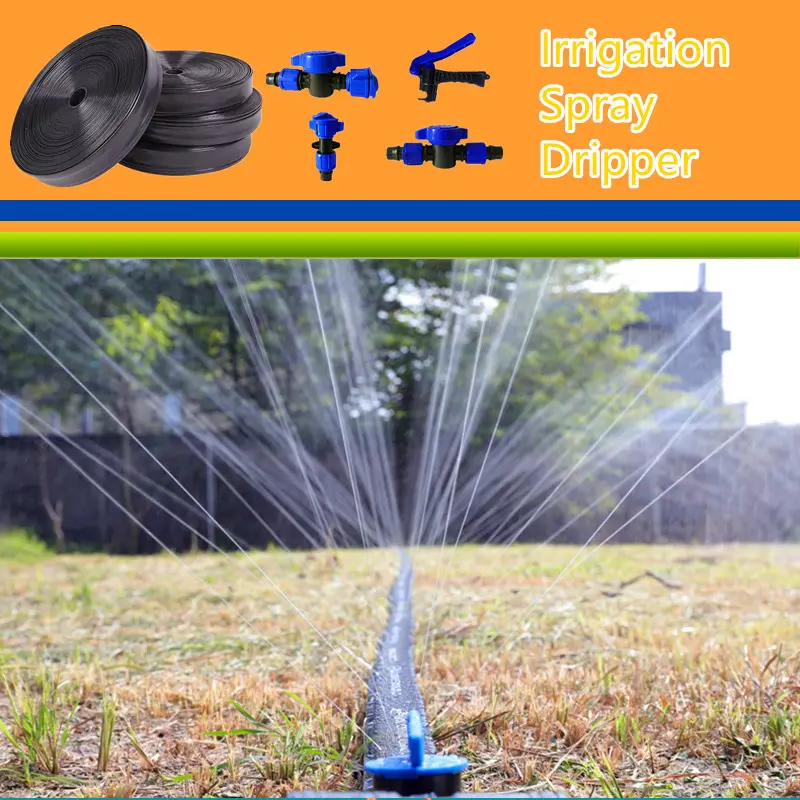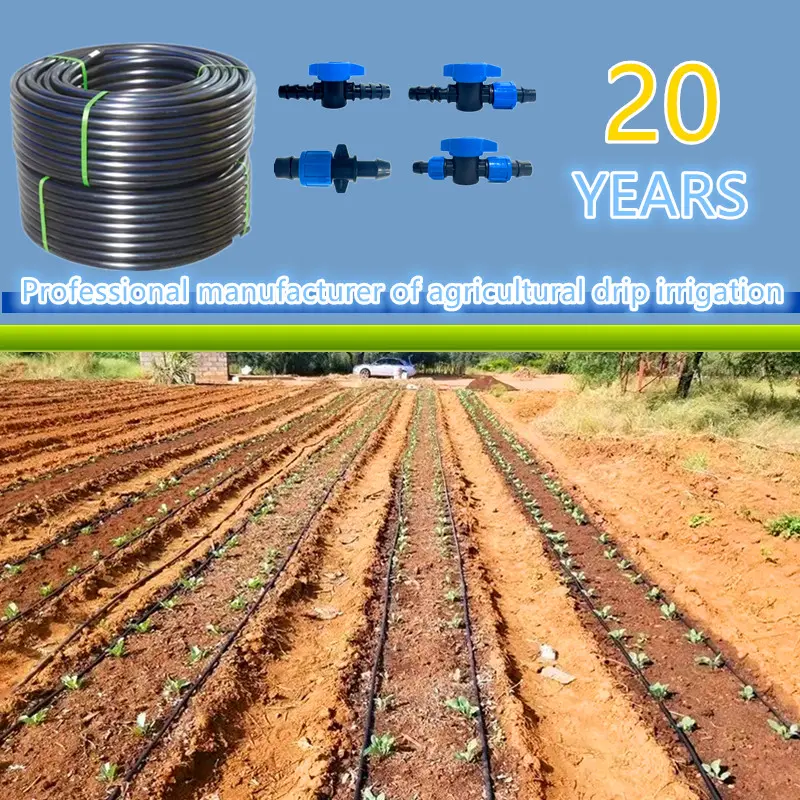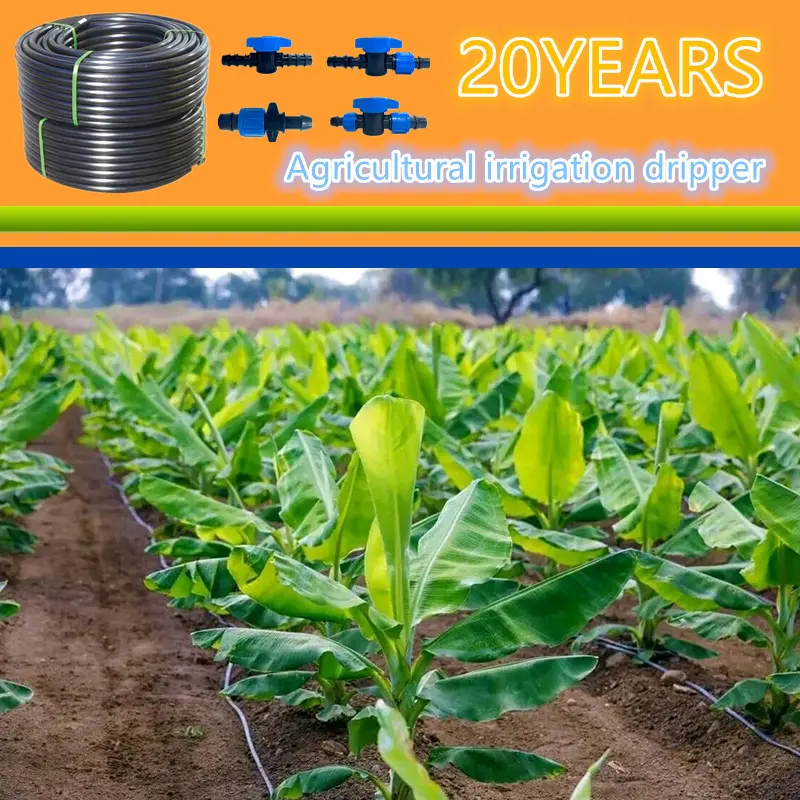The agricultural drip irrigation system is an efficient irrigation method that delivers water directly to the roots of plants through low-flow drip pipes, thereby reducing water waste and evaporation. It is widely used in agriculture and horticulture, and significantly improves crop yield and quality through efficient water resource utilization and precise fertilization technology. The following is a detailed introduction to the working principle and various components of the agricultural drip irrigation system.
1. Working principle
The core principle of the drip irrigation system is to slowly and evenly drip water and nutrients into the plant root zone through a low-pressure pipe system. This method ensures that plants can continuously obtain the right amount of water and nutrients, thereby improving water utilization efficiency and crop yield.
2. Components of the drip irrigation system
2.1. Water source
It can be well water, river water, lake water or other available water sources. The quality of the water source must be good enough to avoid clogging of drippers and pipes.
2.2. Water pump
It is used to transport water from the water source to the drip irrigation system. The choice of water pump depends on the location of the water source, the irrigation area and the pressure required by the system.
2.3. Filter
The filter is used to remove sediment, impurities and microorganisms in the water to prevent drippers from clogging. Common filters include mesh filters and sand filters.
2.4. Pressure regulator
The pressure regulator is used to control and stabilize the water pressure in the system to ensure uniform water flow. Drip irrigation systems usually operate at lower water pressures, usually 10-30 psi (0.7-2.1 bar).
2.5. Trunk and branch pipes
The trunk pipe transports water from the water source to each irrigation area, and the branch pipe distributes the water to each dripper or drip tape. The trunk and branch pipes are usually made of durable materials such as PVC and PE.
2.6. Drip tape or dripper
The drip tape is a flexible pipe with evenly spaced small holes, and the dripper is a small device installed on the branch pipe to drip water evenly. Drip tapes and drippers are key components for slow water release.
2.7. Control system
The control system includes solenoid valves, timers, and sensors to automatically control irrigation time and water volume. Some advanced systems can also be intelligently regulated through soil moisture sensors and weather data.
3. The working process of drip irrigation system
Water supply: The water pump draws water from the water source and filters it through the filter.
Pressure regulation: The water passes through the pressure regulator and is adjusted to the appropriate working pressure.
Water flow distribution: Water is transported to each irrigation area through the main pipe, and then distributed to each dripper or drip irrigation belt through the branch pipe.
Water dripping: The dripper or drip irrigation belt slowly and evenly drips water to the root area of the plant.
Automatic control: The control system automatically opens or closes the solenoid valve to control the irrigation time and water volume according to the preset irrigation plan or sensor data.
4. Advantages of drip irrigation system
Water-saving and high efficiency: Reduce water evaporation and leakage, and the water utilization efficiency can reach more than 90%.
Improve yield and quality: Provide uniform water and nutrient supply to promote healthy plant growth.
Reduce diseases and weeds: Avoid leaf wetting, reduce disease spread, and reduce weed growth.
Save labor: The automated control system reduces the labor intensity of manual irrigation.
Strong adaptability: Suitable for various terrains and crops, especially for areas with scarce water resources.

5. Application Examples
The following are several real-life cases that demonstrate the successful application of drip irrigation systems in different fields.
5.1. Orchards
Case: Citrus orchards in Israel
Israel is one of the first countries in the world to adopt drip irrigation technology, and its citrus orchards have achieved remarkable results using drip irrigation systems. Through the drip irrigation system, the water and nutrients of citrus trees are precisely controlled, avoiding the problem of excessive or insufficient water in traditional irrigation methods. As a result, the yield and quality of citrus have been significantly improved.
Yield increase: The drip irrigation system enables the water utilization rate of citrus trees to reach 95%, which increases the yield by more than 30% compared with traditional irrigation methods.
Water-saving effect: The drip irrigation system reduces water consumption by more than 50%, effectively addressing the local water shortage problem.
5.2. Vegetable planting
Case: Greenhouse vegetables in Shandong Province, China
In Shandong Province, China, many greenhouse vegetable growers use drip irrigation systems for irrigation. The drip irrigation system delivers water and fertilizer directly to the roots of vegetables, reducing water evaporation and soil loss.
Improved yield and quality: The drip irrigation system has increased the yield of vegetables such as tomatoes, cucumbers, and peppers by 20%. At the same time, the quality of vegetables has also been improved, and the fruits are fuller.
Reduced diseases: The drip irrigation system avoids the wetting of leaves, thereby reducing the occurrence of diseases and reducing the use of pesticides.
5.3. Flower seedlings
Case: Tulip cultivation in the Netherlands
The Netherlands is a world-renowned flower producer, and its tulip cultivation widely uses drip irrigation technology. The drip irrigation system provides a stable water supply for tulips, avoiding root diseases caused by excessive water in traditional irrigation methods.
Improved flower quality: The drip irrigation system makes the flowers of tulips more colorful and full, improving market competitiveness.
Cost savings: The drip irrigation system reduces water consumption and labor costs, and improves planting benefits.
5.4. Farmland crops
Case: Cotton cultivation in India
In India, cotton cultivation faces the problem of water shortage. The application of drip irrigation systems in cotton cultivation has significantly improved the efficiency of water resource utilization and increased cotton production.
Significant water-saving effect: The drip irrigation system reduces the water consumption of cotton planting by 40% to 60%, alleviating the pressure of water shortage.
Increased yield: The drip irrigation system increases the yield of cotton by 20% to 30%, bringing higher income to farmers.
5.5. Lawn greening
Case: Golf courses in the United States
In the United States, many golf courses use drip irrigation systems for lawn irrigation. The drip irrigation system provides a uniform water supply for the lawn, keeping the lawn healthy and beautiful.

6. Comprehensive benefit comparison
Compared with the traditional irrigation mode, the agricultural drip irrigation mode has obvious cost and benefit advantages. Let's do a case analysis below. By comparison, it can be seen that although the initial investment of the drip irrigation system is high, it has significant advantages in water saving, increased production and long-term economic benefits.
Case analysis: Take 1 hectare (10,000 square meters) of farmland as an example
Drip irrigation system
Initial investment cost: $5300
Annual operation and maintenance cost: $1300
Water saving benefit: save 50%-70% of water fee each year, about $200-$280
Yield increase benefit: increase yield by 20%-50%, assuming an annual increase in income of $1000-$2500
Traditional irrigation system
Initial investment cost: $2300
Annual operation and maintenance cost: $1450
Water saving benefit: low, no significant water saving
Yield increase benefit: low, no significant yield increase
5-year total cost and benefit comparison table
Project | Drip irrigation system | Traditional irrigation system |
Initial investment cost | $5300 | $2300 |
Operation and maintenance cost over 5 years | $1300 × 5 = $6500 | $1450 × 5 = $7250 |
Total cost | $5300 + $6500 = $11800 | $2300 + $7250 = $9550 |
Water saving benefit over 5 years | $200 × 5 = $1000 | None |
Increased yield benefit over 5 years | $1000 × 5 = $5000 to $2500 × 5 = $12500 | None |
Total benefit over 5 years | $1000 + $5000=$6000 to $1000 + $12500 =$13500 | None |
Net cost | $11800 - $6000=$5800 to $11800 - $13500=-$1700 | $9550 |
Net cost:
Drip irrigation system: $5800 to $-1700 (negative when the benefit is greater than the cost)
Traditional irrigation system: $9550
In the long run, although the initial investment of the drip irrigation system is high, its water-saving and yield-increasing benefits are significant, and the cost can be recovered within a few years and bring higher economic benefits. In contrast, the initial investment of the traditional irrigation system is lower, but the operation and maintenance costs are high, and there is no water-saving and yield-increasing benefits.
Haoyang Environmental Co., Ltd. has been committed to agricultural irrigation for many years and has rich experience and production capacity to meet customers' various customized needs. Please contact us.
Email: sale2@hygeosynthetics.com
Mobile: 8616615773081

897.webp)
942.webp)
237.webp)